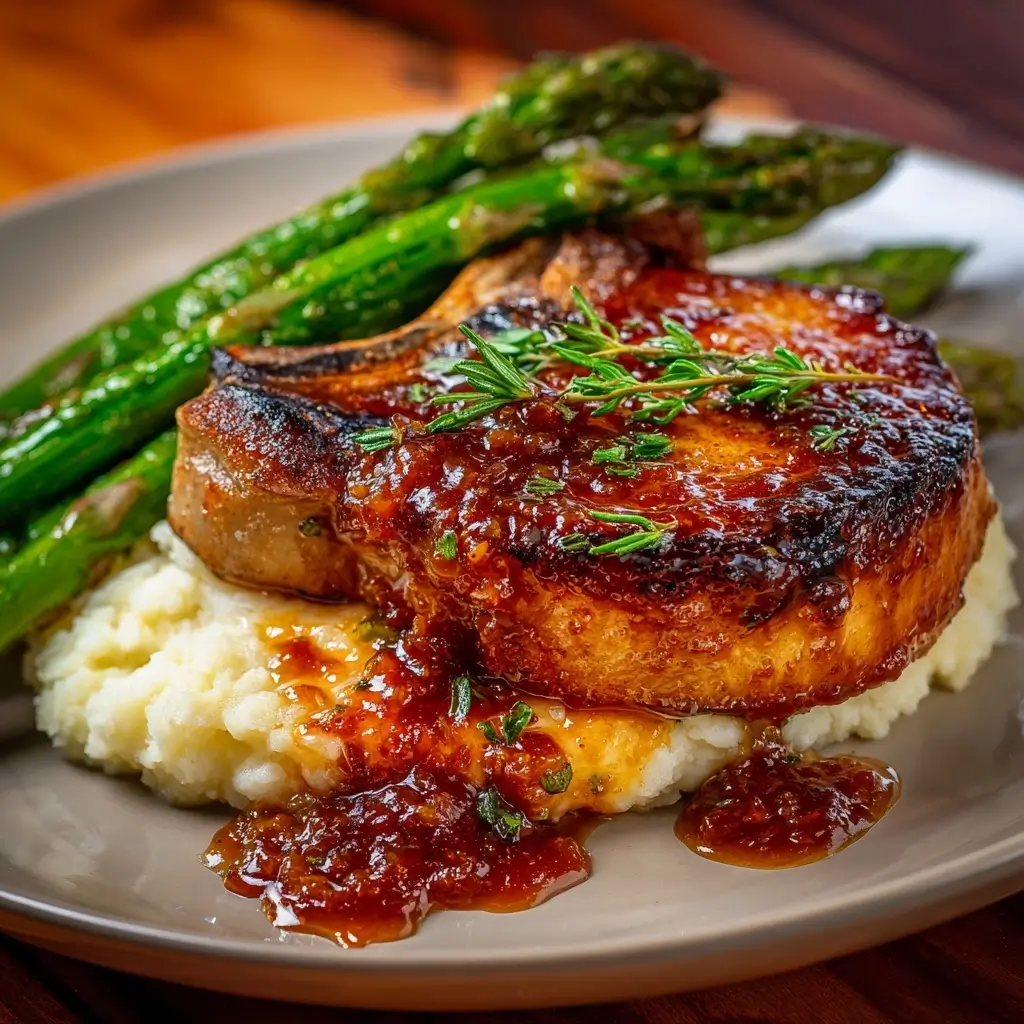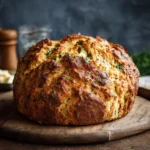Introduction
Apple Butter Pork Chops are a harmonious blend of savory and sweet, bringing together the rich, juicy flavor of pork with the warm, spiced sweetness of apple butter. This comforting dish is perfect for fall and winter meals but can be enjoyed year-round thanks to its balanced taste profile and ease of preparation. Whether you’re cooking for a family dinner or hosting guests on a cozy evening, this recipe delivers both elegance and homestyle warmth in every bite. The natural sugars in apple butter caramelize beautifully when seared, creating a luscious glaze that enhances the tender pork chops without overpowering their delicate flavor.
The History
The concept of pairing pork with apples dates back centuries and spans multiple culinary traditions, particularly in Northern Europe and North America. In countries like Germany, France, and the United Kingdom, apples have long been used in sauces and stuffings served alongside roasted pork. The use of preserved apple products such as apple butter—originally developed as a method of preserving fruit before refrigeration—became especially popular in rural American kitchens during the 18th and 19th centuries. Settlers in Pennsylvania and the Appalachian regions perfected apple butter by slow-cooking apples with spices and cider over open fires, often in large copper kettles. This thick, spiced spread found its way into meat dishes, enhancing the flavor of smoked and fresh pork alike. Over time, home cooks began experimenting with using apple butter as a marinade or glaze, leading to modern recipes like Apple Butter Pork Chops, which showcase how traditional preservation methods continue to inspire contemporary comfort cuisine.
Ingredients Breakdown
The success of Apple Butter Pork Chops lies in the careful selection and balance of ingredients. Each component plays a key role in building layers of flavor, texture, and aroma:
- Pork Chops: Choose bone-in, center-cut pork chops about 1 inch thick for optimal juiciness and flavor retention during cooking. Bone-in cuts provide better heat distribution and contribute depth to the overall taste.
- Apple Butter: Use high-quality, unsweetened or lightly sweetened apple butter made from real apples and warm spices like cinnamon, cloves, and nutmeg. Avoid versions with artificial flavors or excessive sugar, which can burn during searing.
- Olive Oil or Butter: A combination of olive oil (for high-heat searing) and butter (for richness and browning) helps create a golden crust while enhancing mouthfeel.
- Garlic: Fresh minced garlic adds aromatic complexity and pairs beautifully with the sweetness of apple butter.
- Onion: Yellow or sweet onion provides a subtle base note and contributes to sauce development if pan-deglazed.
- Dijon Mustard: Adds tanginess that balances the sweetness of apple butter and helps emulsify the glaze.
- Fresh Herbs: Thyme and rosemary are ideal choices; their earthy tones complement both pork and apples.
- Chicken Broth or Apple Cider: Used to deglaze the pan and create a silky sauce, adding moisture and depth.
- Salt and Pepper: Essential for seasoning and enhancing all other flavors.
- Optional Spices: A pinch of ground cinnamon, allspice, or smoked paprika can deepen the autumnal character of the dish.
Step-by-Step Recipe
- Prepare the Pork Chops: Remove the pork chops from the refrigerator 20–30 minutes before cooking to bring them to room temperature. Pat them dry thoroughly with paper towels—this ensures a good sear. Season both sides generously with salt, pepper, and a light sprinkle of garlic powder or dried thyme.
- Preheat the Pan: Place a heavy-bottomed skillet (cast iron works best) over medium-high heat. Add 1 tablespoon of olive oil and allow it to shimmer but not smoke.
- Sear the Pork Chops: Carefully place the pork chops in the hot pan. Sear undisturbed for 4–5 minutes until a deep golden-brown crust forms. Flip and sear the other side for another 3–4 minutes. Transfer the chops to a plate and set aside temporarily.
- Build the Flavor Base: In the same skillet, reduce heat to medium. Add 1 tablespoon of butter, then stir in ½ cup finely chopped yellow onion. Cook until softened and translucent, about 3–4 minutes. Add 2 minced garlic cloves and cook for an additional 30 seconds until fragrant.
- Add the Apple Butter Mixture: Stir in ½ cup of apple butter, 1 tablespoon Dijon mustard, 1 teaspoon fresh thyme leaves (or ½ tsp dried), and a splash of apple cider or chicken broth to loosen the mixture. Whisk until smooth and bubbling slightly.
- Return Pork Chops to Pan: Nestle the seared pork chops back into the skillet, spooning some of the apple butter mixture over the top. Reduce heat to low, cover the skillet with a lid, and let simmer for 6–8 minutes, depending on thickness, until the internal temperature reaches 145°F (63°C).
- Create a Glaze: Uncover the pan and increase heat slightly. Spoon the sauce over the chops continuously for 1–2 minutes to coat them evenly and thicken the glaze.
- Rest and Serve: Remove the pork chops from the pan and let them rest for 5 minutes. This allows juices to redistribute, ensuring maximum tenderness. Meanwhile, finish the sauce by adjusting consistency with a bit more broth if needed, and season to taste. Drizzle over the rested chops before serving.
Tips
- Don’t Skip the Resting Step: Allowing pork chops to rest after cooking prevents juice loss when slicing and improves texture.
- Avoid Overcooking: Use a meat thermometer to ensure precision. Overcooked pork chops become dry and tough.
- Use Room-Temperature Meat: Cold meat won’t sear properly and may cook unevenly.
- Baste for Extra Flavor: While the chops simmer in the sauce, baste them frequently with the apple butter mixture to infuse flavor throughout.
- Control Sugar Content: If your apple butter is very sweet, balance it with extra Dijon mustard or a splash of lemon juice or vinegar.
- Choose Thick Chops: Thin pork chops cook too quickly and lack the succulence needed for this slow-glazing method.
- Skillet Lid Alternative: If you don’t have a lid, use aluminum foil to trap steam and aid even cooking.
- Make Ahead Sauce: Prepare the apple butter sauce in advance and store it in the fridge for up to 5 days. Reheat gently before using.
Variations and Customizations
Apple Butter Pork Chops are wonderfully adaptable to different tastes, dietary needs, and seasonal ingredients. Here are several creative variations to explore:
- Crockpot Version: After searing the chops, transfer them to a slow cooker. Add the apple butter sauce and cook on low for 4–6 hours for fall-off-the-bone tenderness.
- Grilled Option: Marinate pork chops in apple butter, mustard, and herbs for 2–4 hours, then grill over indirect heat. Baste with extra sauce during the last few minutes.
- Oven-Baked Method: Sear chops on the stove, then transfer the entire skillet to a preheated oven at 375°F (190°C) and bake covered for 15–20 minutes.
- Spicy Kick: Add a pinch of red pepper flakes or a dash of hot sauce to the glaze for a sweet-heat contrast.
- Herb Swap: Replace thyme with sage for a more rustic, Thanksgiving-style flavor, or add fresh rosemary for piney depth.
- Fruit Variations: Mix in pear butter or swap apple butter with quince paste for a unique twist. Fresh sliced apples sautéed with the onions make a delicious garnish.
- Gluten-Free Adaptation: Ensure your apple butter and Dijon mustard are certified gluten-free. Most brands are, but always check labels.
- Dairy-Free Option: Omit butter and use avocado oil or coconut oil instead for a fully dairy-free version.
- Keto-Friendly Adjustments: Use a low-sugar or sugar-free apple butter alternative and substitute with a keto-compliant mustard. Monitor portion sizes accordingly.
- Asian Fusion Style: Incorporate ginger, soy sauce, and rice vinegar into the apple butter mix for an East-meets-West interpretation.
Health Considerations and Nutritional Value
While Apple Butter Pork Chops are undeniably delicious, understanding their nutritional profile can help you enjoy them as part of a balanced diet:
- Protein Powerhouse: Pork chops are rich in high-quality protein, providing approximately 25–30 grams per 4-ounce serving. Protein supports muscle repair, satiety, and metabolic health.
- Vitamins and Minerals: Pork is a good source of B vitamins—especially B1 (thiamine), B6, and B12—which play vital roles in energy metabolism and nervous system function. It also contains selenium, zinc, and phosphorus.
- Fat Content: Depending on cut and preparation, pork chops can range from lean to moderately fatty. Trimming visible fat and using minimal added oils can reduce saturated fat intake.
- Sugar Awareness: Store-bought apple butter may contain added sugars. Opt for homemade or no-sugar-added versions to control carbohydrate content, especially important for those managing diabetes or following low-carb diets.
- Sodium Levels: Seasoning and processed ingredients like mustard or broth can increase sodium. Use low-sodium alternatives when possible and adjust salt to taste.
- Portion Control: Stick to recommended serving sizes (about 4–6 ounces of meat) and pair with fiber-rich sides like roasted vegetables, quinoa, or green beans to enhance fullness and nutrient density.
- Cooking Method Impact: Grilling, baking, or pan-searing with healthy fats preserves nutrients better than frying. Avoid charring meat excessively to minimize formation of potentially harmful compounds.
Nutrition estimate per serving (1 pork chop, 4 oz, with ¼ cup apple butter sauce): ~320 calories, 28g protein, 18g fat (6g saturated), 12g carbohydrates, 1g fiber, 8mg cholesterol, 450mg sodium (varies widely based on ingredients).
Ingredients
- 4 bone-in pork chops (about 1 inch thick)
- Salt and freshly ground black pepper (to taste)
- 2 tablespoons olive oil (divided)
- 1 tablespoon unsalted butter (or dairy-free alternative)
- ½ cup yellow onion, finely chopped
- 2 cloves garlic, minced
- ½ cup apple butter (preferably unsweetened or low-sugar)
- 1 tablespoon Dijon mustard
- 1 teaspoon fresh thyme leaves (or ½ tsp dried)
- ¼ cup apple cider or low-sodium chicken broth
- Optional: ½ teaspoon ground cinnamon or pinch of nutmeg
- Fresh parsley or thyme, for garnish
Directions
- Allow pork chops to come to room temperature. Pat dry with paper towels and season both sides with salt, pepper, and optional garlic powder.
- Heat 1 tablespoon olive oil in a large cast-iron or stainless steel skillet over medium-high heat until shimmering.
- Add pork chops and sear for 4–5 minutes per side until deeply browned. Transfer to a plate and set aside.
- Reduce heat to medium. Melt butter in the same pan, then add chopped onion. Cook for 3–4 minutes until soft and translucent.
- Stir in minced garlic and cook for 30 seconds until fragrant.
- Add apple butter, Dijon mustard, thyme, and optional spices. Pour in apple cider or broth and stir to combine, scraping up any browned bits from the bottom of the pan.
- Return pork chops to the skillet, nestling them into the sauce. Spoon mixture over the top.
- Cover the skillet with a lid and reduce heat to low. Simmer for 6–8 minutes, or until pork reaches an internal temperature of 145°F (63°C).
- Uncover and raise heat slightly. Baste the chops with the sauce for 1–2 minutes to thicken and glaze.
- Remove from heat. Let rest for 5 minutes before serving.
- Garnish with fresh herbs and serve warm with sauce drizzled over the top.
FAQ
Can I use boneless pork chops?
Yes, but they cook faster and are more prone to drying out. Reduce searing time and monitor internal temperature closely—boneless chops may only need 4–5 minutes total after searing.
Is apple butter the same as applesauce?
No. Apple butter is concentrated applesauce that has been slowly cooked down with sugar and spices, resulting in a thicker, richer, and sweeter product. Using applesauce will result in a thinner sauce with less depth.
Can I make this recipe ahead of time?
Yes! You can sear the chops and prepare the sauce up to one day in advance. Store separately in the fridge, then reheat gently and finish cooking just before serving.
How do I store leftovers?
Store cooled pork chops and sauce in an airtight container in the refrigerator for up to 3–4 days. Reheat gently in a skillet or microwave, adding a splash of broth to refresh the sauce.
Can I freeze Apple Butter Pork Chops?
Yes. Freeze in a freezer-safe container for up to 3 months. Thaw overnight in the fridge before reheating. Texture remains good, though the sauce may separate slightly—simply stir while warming.
What sides go well with this dish?
Excellent pairings include mashed potatoes, sweet potato purée, wild rice, roasted Brussels sprouts, sautéed kale, or a crisp autumn salad with walnuts and vinaigrette.
Can I use homemade apple butter?
Absolutely! Homemade apple butter is ideal, as it typically contains fewer preservatives and allows you to control sweetness and spice levels.
Why did my sauce turn bitter?
This can happen if the apple butter burned during cooking. Always use moderate heat when reducing the sauce and stir frequently. Deglaze the pan promptly after searing to prevent stuck-on bits from scorching.
Summary
Apple Butter Pork Chops combine tender, juicy pork with a rich, spiced apple butter glaze for a comforting dish that’s both elegant and easy to make. Perfect for weeknights or special dinners, this recipe blends tradition and flavor in every bite.










